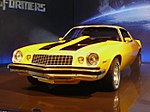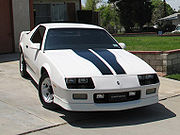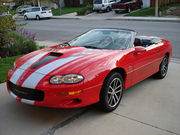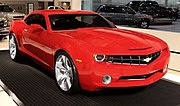 | |
| Manufacturer | General Motors |
|---|---|
| Production | 1967–2002 2009- |
| Class | Pony car |
| Body style(s) | 2-door coupe 2-door convertible |
| Layout | FR layout |
| Platform | F-body (1967-2002) Zeta platform (2010+) |
| Related | Pontiac Firebird |
Origin
Though the car's name was contrived with no meaning, Chevrolet researchers reportedly found the word in a French dictionary as variation of informal speech (slang) for "friend", "chum", or "companion."[citation needed] In some automotive periodicals before official release, it was code-named "Panther"; however, the project designation for the Camaro was XP-836 and some early GM photos show the final Camaro body labeled "Chaparral".[2] Automotive press asked Chevrolet product managers "What is a Camaro?", and they were told it was "a small, vicious animal that eats Mustangs".[3] The name conveniently fits Chevrolet's "C" naming structure that included Corvair, Chevelle, Chevy II, and Corvette.
The Camaro was initially advertised on contemporary hit radio (Top 40) AM stations of the day in an attempt to woo the young adult market.[citation needed] Technically a compact (by the standards of the time) pony car, the Camaro could also be classified as a sporty muscle car or an economical grand tourer, depending on the selected optional equipment.
[edit] First generation
The first-generation Chevrolet Camaro debuted in September 1966, for the 1967 model year, up to 1969 on a brand new rear-wheel drive GM F-body platform and would be available as a 2-door, 2+2 seating, coupe or convertible with a choice of inline-6 and 302 CID (4.9 L), 307 CID (5.0 L), 327 CID (5.4 L), 350 CID (5.7 L), or 396 CID (6.5 L) V8 powerplants. Concerned with the runaway success of the Ford Mustang, Chevrolet executives realized that their compact sporty car, the Corvair, would not be able to generate the sales volume of the Mustang due to its radical rear-engine design, as well as declining sales, partly due to bad publicity from Ralph Nader's book, Unsafe at Any Speed. Therefore, the Camaro was touted as having the same conventional rear-drive, front-engine configuration as Mustang and Chevy II. In addition, the Camaro was designed to fit a variety of power plants in the engine bay. The first-generation Camaro would last until the 1969 model year and would eventually inspire the design of the new retro fifth-generation Camaro.
[edit] Second generation
Introduced in February 1970, the second-generation Chevrolet Camaro would be in production for a total of 11 years. The car grew somewhat larger and wider with the new styling, thus resulting in a heavier car.[4] Still based on the F-body platform, the new Camaro was engineered much like its predecessor in that it still used a unibody structure with a front subframe, leaf springs in the back and A-arms up front for suspension. The car would see major changes in both styling and performance as time progressed from the introduction through the end of second-generation production in 1981.
[edit] Third generation
The third-generation Chevrolet Camaro was introduced for the 1982 model year. It continued to use General Motors' F-body platform and would produce a "20th Anniversary Commemorative Edition" for 1987 and a "25th Anniversary Heritage Edition" for 1992. These were also the first Camaros with throttle body fuel injection, Turbo-Hydramatic 700R4 four-speed automatic transmissions, five-speed manual transmissions, 15 inch or 16-inch wheels, hatchback bodies, and a rear window third brake light. It was during the third generation that the famous IROC-Z Camaro (International Race Of Champions) was available, which included upgrades such as Performance Suspension and 16-inch Z rated tires.
The third-generation Camaros would continue through the 1992 model year.
[edit] Fourth generation
The fourth-generation Chevrolet Camaro debuted for the 1993 model year on an updated F-body platform. It would retain the same characteristics since the first-generation's introduction back in 1967; 2-doors, 2+2 seating, available as a coupé (with optional T-top roof) or convertible (with the latter introduced in 1994), rear-wheel drive, and a choice of V6 and V8 powerplants. Options included the 3.4 L (207 CID) 160 hp (119 kW) V6 (changed to 3.8 L (232 CID) 200 hp (149 kW) V6 in mid-1995) and the LT1 V8 engine (350 CID) 5.7 L V8 with 275hp (flywheel rated) that had been introduced in the Corvette one year earlier, as well as an optional six-speed manual transmission.(The motor was later rated at 285hp) The 1997 model year introduced a newer interior, while the 1998 model year was refreshed and revised with both exterior and engine changes. The engine was replaced with GM's all-aluminum LS1 (346 CID) which had been introduced with the Corvette C5.
The fourth-gen Camaro would last up through the 2002 model year, marking 35 years of continuous production. Production of the F-Body platform was stopped due to slow sales, a deteriorated sports coupe market, and plant overcapacity.[5][6]
[edit] Fifth generation
Based on the 2006 Camaro Concept[7] and 2007 Camaro Convertible Concept, production of the fifth-generation Camaro was approved on 5 August 2006. Oshawa Car Assembly will produce the new Camaro [8] which will go on sale in spring of 2009 as a 2010 model year vehicle.[9][10] The 2010 model is offered as a coupe only in LS, LT, and SS trim levels.[11] The LS and LT trim levels will be powered by the LLT 3.6 L (≈220 in3) V6 producing 300 hp (220 kW). The SS with manual transmission is powered by the LS3 6.2 L (≈378 in3) V8 producing 422 hp (315 kW) while the SS with automatic transmission is power by a new L99 6.2 L V8 with Active Fuel Management producing 400 hp (300 kW). The RS appearance package will be available on both the LT and SS. Production will begin on 16 February 2009 as a 2010 model year.[12]
[edit] Racing
| Please help improve this article or section by expanding it. Further information might be found on the talk page or at requests for expansion. (August 2007) |

The Camaro was one of the prominent vehicles in the SCCA-sanctioned Trans-Am Series, having won the title in 1968 and 1969 by Mark Donohue. Maurice Carter of car dealer Maurice Carter Chevrolet-Oldsmobile in Hamilton, Ontario, Canada took a new Camaro off his lot and entered the 1970 Trans Am series. Carter earned the highest placed Canadian independent driver score of all the Trans-Am racers. Camaro were in use in Trans-Am until the late 1990's and won further titles in 1991, 1992, 1993, 1994, and 1998.

A Camaro driven by Bob Jane also won 2 championships in the Australian Touring Car Championship, now known as V8 Supercars), in 1971 and 1972.[13]
The Camaro was the official car of and used in the International Race of Champions starting in 1975 and lasting for 12 years until 1989. It was the first American car of the series succeeding the Porsche Carrera RSR.
Today, Camaros are raced in many forms of auto racing throughout the world. They are a favorite in drag racing and can be currently found in several series from the National Hot Rod Association, International Hot Rod Association, and United States Hot Rod Association. Road racing Camaros can currently be found in the Sports Car Club of America's American Sedan series. They have also been the exclusive vehicle used in the Swedish Camaro Cup series since 1975.
[edit] Appearances in popular culture
 |  | |
| Bumblebee depicted as a 1976 and 5th-gen Camaro. | ||
The Camaro is referred to in songs such as "Camaro Man" by Blue Meanies, "Bitchin' Camaro" by Dead Milkmen, "Go Lil' Camaro Go" by The Ramones, "Camaro" by Kings of Leon, "The List" by Metric, "Wishlist" by Pearl Jam, "Teenage Dirtbag" by Wheatus, "Kountry Gentleman" by Family Force 5, "Aldemaro en su Camaro" by Los Amigos Invisibles and "Ego Booster" by Astrosoniq. Bruce Springsteen, a lifelong fan of Chevrolets, refers to the Camaro in "Racing In The Streets".
Madonna's music video for "What It Feels Like for a Girl" features a second generation Camaro. She is seen hotwiring the car and crashing it into a police car. Also in the music video "All Summer Long" by Kid Rock. In this video appears a blue third generation Camaro
The Camaro has also made several notable appearances in film. One of the most popular movie Camaros was a black 1967 model driven by actor John Cusack in the 1985 film Better Off Dead.[14]
In addition, the Camaro continues to find its way into modern day fiction. The vehicle mode of the character Bumblebee in the 2007 film, Transformers, is first a 1976 model Camaro[15] and later a fifth-generation concept variant. A modified fifth-generation Camaro will reprise the role of Bumblebee in the upcoming sequel, Transformers: Revenge of the Fallen.
Top Gear's American fly-drive special featured a 1989 Camaro RS, bought by presenter Jeremy Clarkson for US$800 in Miami. During the filming, Clarkson became rather attached to the car, at one point stating that "I'd rather be in this now than an Enzo."[16]
In the music video for the Metalica song I Disappear, James Hetfield is seen driving/jumping a black 1967 Camaro in Los Angeles.
Various models of the Camaro have been featured in game series such as Forza Motorsport, Gran Turismo, L.A Rush, Midnight Club 3: DUB Edition Remix, Need for Speed series, and Sega GT 2002.





No comments:
Post a Comment